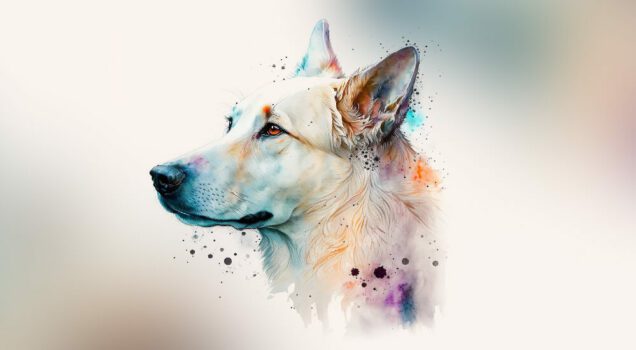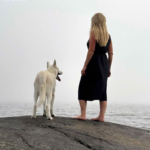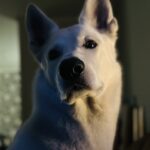
My thoughts about breeding – part 3
2 years ago by Linda
For those of you who follow and read my website, which is updated quite irregularly, you might have had time to read about My thoughts on breeding, part 1 and part 2. I chose to make the posts invisible to you readers after a while because I had a thought that I would summarize everything in one writing, but now I changed my mind. Parts 1 and 2 are thus available here on the website again, in addition to the fact that I am now publishing part 3.
I wrote Part 1 and 2 almost exactly a year ago, and since then a lot has actually happened – development has moved forward!
I was convinced that I couldn’t have a litter in 2022 because I couldn’t find a suitable male dog, but thankfully, through my network of incredible people, I got hold of a male that I felt could contribute to my breeding, although we are talking about contributions in very small components. I currently have 7 puppies that will soon be 3 weeks old.
In part 1 I wrote about the three different pools, pool 1, 2 and 3. The male who is the father of my almost 3 week old litter is called Ruffy and he has 50% DNA from pool 2, that is, his father is a colored German Shepherd. Ruffy is owned by a wise breeder in Finland who for many years has really tried tobreed for genetic variation.
What does this mean for the seven little trolls in the puppy box? Well, this means that they have brought with them DNA from the original population, that is, the population from which the white shepherd was separated 20-30 years ago (which, by the way, is an incredibly short time from a genetic perspective). It thus does not mean “new” genes, but new old genes. In other words, it is a very small step on the way to increased genetic variation within the white shepherd dog, but all journeys start with a step, right?
It also means that some puppies may turn out to be a little more golden in their coats, a problem for those who primarily have their dogs to go to shows, but thankfully that is not the primary goal for either me or my puppy buyers. We want to strive for dogs that are as healthy as possible, not dogs that are as white as possible.
That the grandfather of the puppies is a German shepherd will also mean a certain stigma in the VH world, as a number of very conservative people consider this to be mixed breed, an expression that has a negative connotation, at least if you look at the culture that is established in the kennel club world. The puppies will be given a pedigree stating that they are White Shepherds as the father is registered as a White Shepherd and the mother is a White Shepherd. This stigma is based on feelings, which in turn are rooted in a culture that we, through organizations, have established through various documents and regulations, not necessarily based on research and knowledge of genetics. All puppies are DNA tested and I have deliberately chosen not to state breed when I activated their Embark accounts, but I am waiting for their genome to be sequenced. It will be extremely exciting to get to know their DNA results and I look forward to sharing their results with their future owners. Will their DNA establish that they are 100% white shepherds? It remains to be seen!
Is this litter the solution to the problem created by closed stud books? No, far from it. It is a relatively short-term solution, if you only think one litter at a time. Hopefully, this litter will have a slightly lower genetic inbreeding rate than average, but as I said, it won’t get new genes, it will get new old genes. It will hopefully have a high genetic variation, as we partially used the “water from pool 2”. When this litter later (if all goes well) can contribute to new generations, the genetic inbreeding rate will rise again, if they are bred back to the white shepherd population. But before that time, I hope that new healthy genes have entered our population that we can use in our breeding.
In addition to the development in the small perspective, i.e. my own breeding, our kennel club SKK has now actively started to inform about the importance of genetic variation. I have attended one of SKK’s meetings under the slogan SKK 2030 – a tour of SKK around Sweden where they ask us members how we think SKK should look in the future. I went to Hudiksvall to participate as it was the closest meeting geographically and I was met by nice fellow breeders from a large number of breeds. Common to many of us was our concern about how closed stud books negatively affect our breeds and to my great joy SKK addressed this issue in their presentation. SKK has understood that we are watering down our breeds on genetic variation, there is no doubt about that. What they can do about it rests very much with us, you and me and all the other members who are the basis for SKK’s survival. I want a strong, well-functioning organization to support me, an organization that puts the dog’s well-being at the top of the agenda, so I am very happy when these signals come from SKK.
I will attend SKK ‘s breeding conference in November, which will be exclusively about genetic variation, a conference that I am really looking forward to. In addition, SKK will hold a webinar on genetic variation in December, which I will also participate in, I hope. The webinar is open to anyone who wants to participate, there is usually only one limitation and that is the number of participants (in previous webinars there have been a maximum of 200 participants who could participate). I think there is planning behind the time sequence, i.e. to first have a breeding conference where the participants are elected officials within breed clubs and then a webinar . This new thinking needs to be anchored, first among those who hold a seat in their breed clubs, then among the members at large because there are still a large number of people out there who believe that crossbreeding for increased genetic variation is something negative – a remnant of the culture we have built up over a long time time and probably a remnant that we will have to live with for many years to come. But the development is moving forward!
Those were my thoughts for the day. I know, as I mentioned before, that my thoughts are considered radical by a number of other breeders, but that doesn’t matter. Anyone who reads this and thinks I’m wrong is welcome to refute me, but not with feelings and a moral view of what the world should look like (because I’m completely uninterested in that and don’t spend my time on it) but with research and facts that support the argument.
In the usual order I link, first to part 1 and part 2 of My thoughts on breeding, then you can via the image from the website of International Shiloh Shepherd Alliance click on to their very interesting text about outcross , i.e. crossbreeding.
Then you can read about our new Nobel laureate Svante Pääbo and his fantastic research on DNA, not because he researched dogs but because DNA is inherited the same regardless of organism. And finally, as always, I encourage you to seek knowledge of genetic variation and breeding for yourself.
Related posts
Posts that are published in the same categories.


